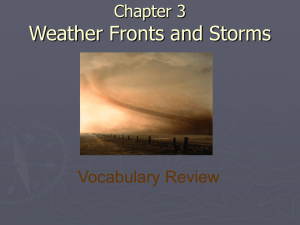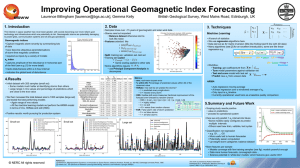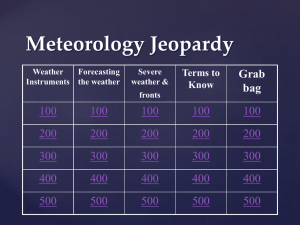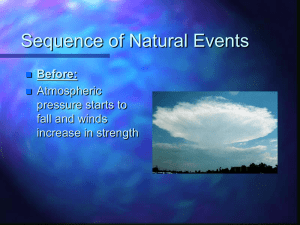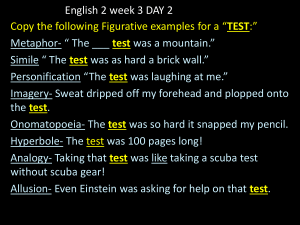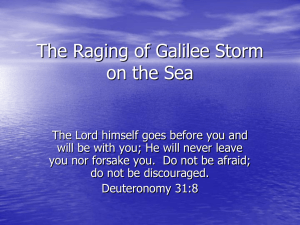The 100-Year Storm Redefined
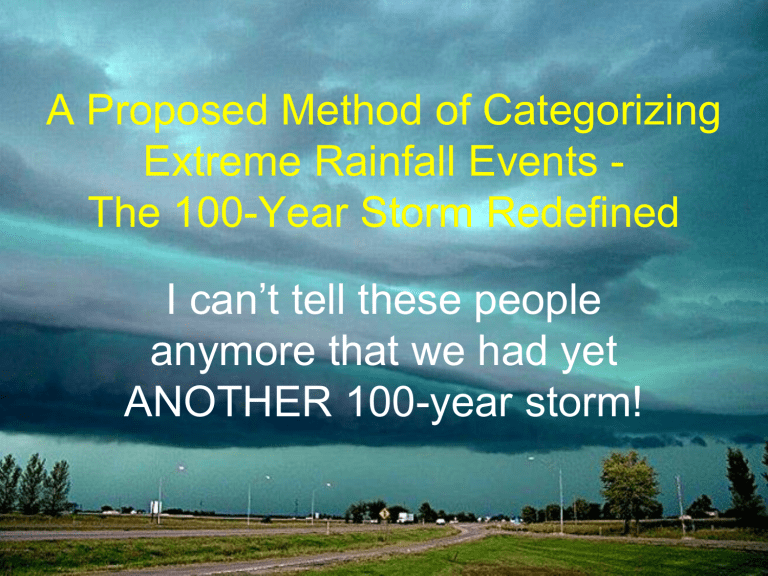
A Proposed Method of Categorizing
Extreme Rainfall Events -
The 100-Year Storm Redefined
I can’t tell these people anymore that we had yet
ANOTHER 100-year storm!
History of Flooding in Brookfield
Historic flooding events:
March 1897
June 1917
June 1940
March 1960
July 1964
September 1972
April 1973
Recent Flooding in Brookfield
Recent history of flooding in Brookfield
August 6, 1986 – 6.8” in 24 hours
June 20 - 21, 1997 – 6” in 26 hours
August 6, 1998 – 11.35” in 8 hours
June 7 - 8, 2008 – 5.8” in 24 hours
June 19, 2009 – 4.8+” in 3 hours
All 100-year storms or larger!
Wisconsin: 14-Day Precipitation
Valid at 6/16/2008 1200 UTC
Radar image of precipitation in June 2008
Why Call Them 100-Year Storms?
2” rains are different depending where you are
Need something that can be used consistently across the country
Account for variability in these storms by region
100-Year Storms
Recurrence interval
Based on probability of the storm occurring
How can there be two 100-year storms in a row?
Let’s Call Them Something Else
1% probability storm
Aren’t we clever?
Public knows 1% = 1/100
They figure out that it’s the 100-year storm
Now they feel like we tried to deceive them – hiding behind probabilities
Probability of the 100-Year Storm
Probability of 100-year event: p = 0.01
100-year event occurring three years in a row?
p 3 = (0.01) 3 = 0.000001 or 1 in a million
Not always intuitive
100-year event occurring once in 100 years?
1-(1-p) 100 = 1-(0.99) 100 = 1-0.366 = 63.4%
Public thinks it would occur once every 100 years
Binomial Probability Applied to
Extreme Events
More complex relationships
100-year event occurs 5 times in 25 years? n !*p Y *(1-p) ( n -Y) / (Y!)*( n -Y)!
25!*0.01
5 *(0.99) 20 / 5!*20! = 1 in 4.4 million
Is this pretty rare?
Consider what people are willing to gamble on
Probability and Statistics
Winning the Powerball Lottery: 1 in 195 million
One Fatal Flaw
People don’t understand statistics
Public’s response to 100-year storm?
“Oh good, we’re safe for another 99 years.”
Two 100-year storms in a row?
“This storm was different than last year’s storm, so they both can’t be called the 100year storm. Can they?”
Public Confusion
Mark Twain said, “The more you explain it, the more I don't understand it”
Public more likely to respond this way
Public Response
Disbelief
Disgust
Cynicism
Look for someone to blame
Affects our credibility
Less likely to take our advice in future
Rating Other Natural Disasters
Earthquakes
Richter scale
Measurement of
Energy released
Strength
Duration of its seismic waves
Rating Other Natural Disasters
Tornadoes
Fujita scale
(enhanced since
2007)
Measurement of
Intensity
Area affected
Rating Other Natural Disasters
Hurricanes
Saffir- Simpson scale
Measurement of
Barometric pressure
Wind speed
Storm surge
Rating Other Natural Disasters
None of these natural disasters are rated using probabilities or recurrence intervals
Something that implies severity of the storm, not rarity of the storm
Use a scale instead to rate the event
Easily understood, the higher the number, the worse the natural disaster
Revise Terminology for
Communication with Public
Keep It Simple
S_ _ _ _ _
Use recurrence intervals as basis
Don’t call them 100year storms
Use a scale like other natural disasters
A New Rating System Proposed
RI = 2 (G-1)
RI = Recurrence Interval of the rain event
G = the Category of storm
Example:
G-factor of 7 in the formula is 2 (7-1) = 2 6 equals the 64-year event
Categorizing Storms Based on
Recurrence Intervals: RI = 2 (G-1)
Category of Storm Recurrence Interval Rain Storm
G - 2 2 to 4 year
G - 3
G - 4
G - 5
G - 6
4 to 8 year
8 to 16 year
16 to 32 year
32 to 64 year
G - 7
G - 8
G - 9
64 to 128 year
128 to 256 year
> 256 year
Placing the Recurrence Interval
Storm into the New Rating System
Recurrence Interval
Rain Storm: RI = 2 (G-1) G - Factor
2-year 2
5-year
10-year
25-year
50-year
100-year
3.32
4.32
5.64
6.64
7.64
Category of
Storm
G - 2
G - 3
G - 4
G - 5
G - 6
G - 7
Simple G-Factor Table
Recurrence Interval
Storm
Duration 2-year 5-year 10-year 25-year 50-year 100-year
1 hour
2 hour
2
2
3
3
4
4
5
5
6
6
7
7
3 hour
6 hour
2
2
3
3
4
4
5
5
6
6
7
7
12 hour
24 hour
2 day
3 day
5 day
10 day
2
2
2
2
2
2
3
3
3
3
3
3
4
4
4
4
4
4
5
5
5
5
5
5
6
6
6
6
6
6
7
7
7
7
7
7
Different Durations of 100-Year
Storms Have Different Effects
2.8 inches of rain in one hour will wash out roads, culverts, and “flood” streets for a time
7.5 inches of rain in ten days causes rivers to overtop with widespread flooding
Need to Account for Differences
Develop adjustment factors for G
New formula: G
ADJ
= G x (DAF) x (IAF)
G = the Category of storm
Duration adjustment factor
Intensity adjustment factor
Intensity & Duration Adjusted
Category Storms
Recurrence Interval
Storm
Duration
1 hour
2 hour
3 hour
6 hour
12 hour
24 hour
2 day
3 day
5 day
10 day
2-year 5-year 10-year 25-year 50-year 100-year
0
1
1
1
1
2
2
2
3
3
3
4
1
1
1
1
1
1
2
2
1
1
1
2
2
2
3
4
2
2
2
2
3
3
4
5
3
3
3
4
5
5
5
7
3
4
5
5
6
6
6
8
7
9
6
7
7
7
5
6
Brookfield Flooding Revisited
August 6, 1986: 6.8” in 24 hours = G-8
June 20 21, 1997: 6” in 26 hours = G-7
August 6, 1998: 11.35” in 8 hours = G-10+
June 7 8, 2008: 5.8” in 24 hours = G-7
June 19, 2009: 4.8+” in 3 hours = G-6
No implication of rarity!!!
Criticism and Scrutiny
No continuous curve for each category storm
Interpret between durations to pick the right category storm
Or develop a look-up table or formula to interpolate (any grad students looking for a project?)
Criticism and Scrutiny
Does not address:
antecedent moisture,
snowmelt,
soil types,
% of impervious cover,
etc.
Not intended to!
These relate to runoff, not the rain storm event
Criticism and Scrutiny
Just another name for the 100-year storm
Precisely. That’s the point!
Better way to communicate to public
Severity, not rarity, is key to public’s understanding
Advantages of a New System
Preserves the existing data and science
Does not require overhaul of hydrology or engineering
Generally consistent with rating systems for other natural disasters
Easy to understand
Bigger the number, the bigger the storm
Advantages of a New System
Provides a more appropriate scaling factor
The 50-year storm is not 50% as big as the 100-year storm as some might assume
It is almost as big (Typically only 1 unit away)
Uses different terminology than for floodplains
Avoids confusion that 100-year storm always results in the 100-year flood
Or that the 100-year flood can only occur when there’s a 100-year storm
Advantages of a New System
Does not imply that big storms are rare
Minimizes criticism, skepticism and general disregard for hydrologic or engineering descriptions of the event
Makes it clear to people that these are big storms that we should take seriously
Incents people to protect themselves against larger event
Does This Make Sense?
What’s Next?
Does this process have merit?
Academia support?
NOAA, USACE HEC support?
Anyone with me?
Your Turn for Feedback!
For copies of this presentation or white paper: email me at: grisa@ci.brookfield.wi.us
